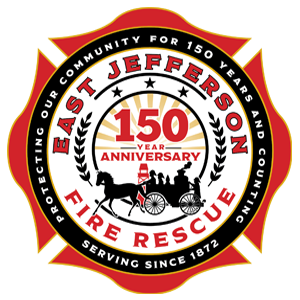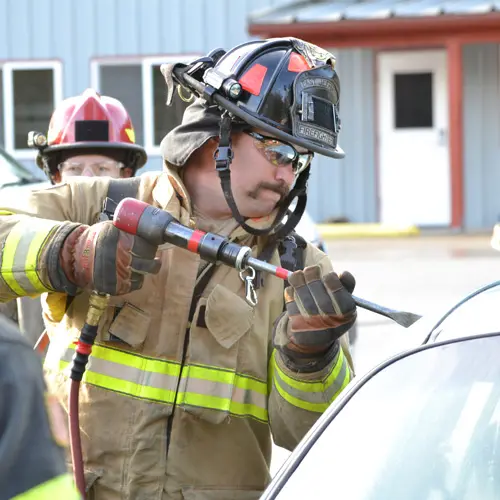East Jefferson Fire Rescue provides more than just fire engines when you need them. We provide emergency medical response, fire suppression, technical rescue, marine services and a whole lot more. Under the federal response model this is referred to as ‘all hazards response’.
These response activities require highly trained individuals to provide these services. Many factors drive the training that your firefighters receive, from insurance industry training guidelines, to Washington State Firefighter Safety standards for training proficiency and other ongoing certification training.
Under the all hazards response envelope, EJFR provides to its community the following services:
EJFR training includes training for emergency medical incidents including ALS and BLS response, fire response to homes, commercial buildings industrial complexes, urban interface / wildland fires and marine fires, fire investigation inspection and prevention, automobile accident extrication, technical rescue for trench collapse, high angle rope rescue, confined space, heavy machinery entrapment, hazardous materials spills and releases, marine surface water rescues, and fire command officer training including current tactical operations.
Firefighter Training
Standards of Accreditation
EJFR has adopted the “International Fire Service Accreditation Congress” certification program under the Washington State Fire Protection Bureau.
All of our career firefighters are certified at minimum as ‘IFSAC Firefighter 1’ meeting the requirements of NFPA 1001 “Standard for Fire Fighter Professional Qualifications.”
Every volunteer firefighter is either certified IFSAC FF1 or Washington State Firefighter 1.
Additionally all of our fire officers (lieutenant or higher) are certified IFSAC Fire Officer 1 or higher.
By having your firefighters and fire officers certified as firefighters and fire officers, they have proven that they can perform to a specified level as established by an accredited review board in the discipline of firefighting, hazardous materials operations and fire command and management.
Firefighting Operations
This division manages day-to-day activities of the fire department’s response to calls for service that originate via 911 or walk-in to the fire station.
When you see fire engines and ambulances responding to a call, there is science behind the response. Jefferson County utilizes its own 911 call center called JeffCom.
There, trained dispatchers process the 911 call for type of need, location and other pertinent information. From there the dispatcher utilizes Computer Aided Dispatch (CAD) software that recommends particular fire and emergency medical apparatus to respond to the incident. This recommendation has been designed by the fire department operations division.
Utilizing the United States Fire Administration fire flow calculation model and staffing criteria, the response recommendation is designed to the address of the specific call.
Emergency Medical Services (EMS) Training
Because approximately eight out of every 10 calls we respond to are EMS-related, medical training is a high priority.
Our department offers an EMT class one to two times per year, which is recognized by Washington State and and enables graduates to take the state EMT exam for certification.
Our EMT’s and Paramedics have opportunities to learn from local physicians, with recent class subjects ranging from scuba diving medical emergencies to pandemic influenza.
We also receive training through the Medic One program at the University of Washington and Harborview Medical Center in Seattle.
Besides lectures we have many hands on opportunities for maintaining our practical medical skills. Backboarding, splinting, practicing IV’s and CPR are a regular part of our training program. We also continually practice and train for Multiple Casualty Incidents.
2020 Northwest Region EMS Protocols
Training for Special Operations
When people experience an unusual emergency and don’t know who else to call, the fire department usually is brought in to address the situation. As a result, EJFR regularly trains for a variety of special operations.
On several occasions, people and dogs have fallen off the bluffs of Ft. Worden State Park, necessitating high-angle rescues. These types of rescues involve advanced rope skills in a team environment. EJFR regularly trains for high-angle rescues in anticipation of future incidents.
Enclosed space training is also a regular event at EJFR. During this type of training, firefighers must modify their methods of transporting personal protective equipment in order to make passage through the confined spaces.
Officer Development
EJFR has adopted the “International Fire Service Accreditation Congress” certification program under the Washington State Fire Protection Bureau.
Our career Fire Officers at minimum are certified as ‘IFSAC Fire Officer 1,” meeting the requirements of NFPA 1021 “Standard for Fire Officer Professional Qualifications.”
In the adoption of IFSAC certifications, the Department Fire Officers must pass educational elements which are required before appointment to Lieutenant. All Fire Officers also have continuing educational requirements as established by local, state and federal regulations.
The process for a firefighter to become a Fire Officer within EJFR is a multi-step process that establishes a foundation for the Fire Officer. EJFR Verifies the Fire Officer foundation through first step IFSAC certification at Fire Officer 1. Along with the certification, the Officer candidate completes an “Acting in Position Task Book” equivalent to the NWCG (National Wildfire Coordination Group) and NIMS (National Incident Management System) which validates skills and applied tasks through direct mentorship and evaluations by senior officers within the organization.
EJFR offers officer development courses that address Incident Management, Personnel Management, Finance, Operations and Fire Prevention. Additionally, monthly tactical training utilizing table top and video simulations are mandatory for EJFR Fire Officers.
EJFR Fire Officers are highly trained professionals providing leadership, management, and supervision to a highly trained response force who respond 24/7 to the needs of the community.
Training Donations
Contact: (360) 385-2626
We always welcome the donation of old vehicles so we can use them in our training exercises.
We also value the donation of building materials, especially 4′ x 8′ sheets of plywood. We use construction materials in our fire training in ways ranging from breaking through walls to chainsawing ventilation holes in a roof. If you have some materials to donate call us at (360) 385-2626 and we’ll arrange to pick them up.
House Burn Donations
Through your house donation we are able to provide internal and external training exercises that will either establish new operational methodologies or enhance current practices.
East Jefferson Fire Rescue has three options available to structure owners for the use of the buildings being offered:
1. Non-destructive training
2. Destructive training
3. Destructive training with live fire
In option # 1, East Jefferson Fire Rescue would use your structure for training with the emphasis in non-destructive training methods. i.e. general search and rescue, thermal imaging.
In option # 2, East Jefferson Fire Rescue would use your structure in coordination with your demolition contractor to facilitate destructive training. This would include wall breaches, roof ventilation, building collapse exercises. At the end of the prescribed training the building would be demolished by a permitted contractor.
In option # 3, East Jefferson Fire Rescue would use your structure for destructive training with the end of the project to cumulate in a live fire exercise.
Contact: training@ejfr.org

